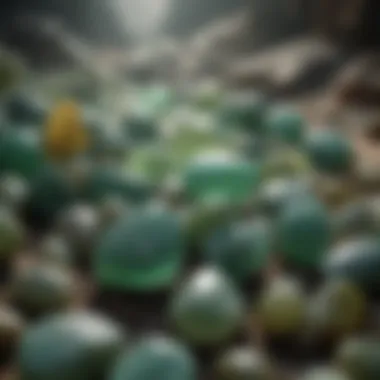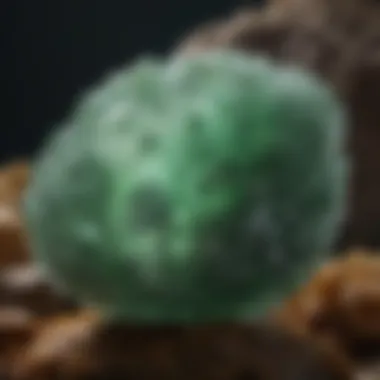Unveiling the Enigmatic World of Identifying Jade Rocks


Rock and Fossil Identification
When it comes to identifying jade rocks, a meticulous understanding of their types and characteristics is essential. Jade, a highly esteemed natural gemstone, varies in forms ranging from nephrite to jadeite. Nephrite jade is known for its toughness and wide color range, while jadeite is renowned for its translucency and vibrant hues. To distinguish between these types, collectors must scrutinize the color, luster, texture, and overall appearance of the rock. Utilizing specialized tools like magnifying glasses and hardness testing kits can aid in precise identification.
Geological Insights
Delving deeper into the geological aspects of jade rocks unveils their fascinating origins and formation processes. These gemstones are typically found in metamorphic regions, where intense pressure and heat transform minerals into the intricate patterns and colors characteristic of jade. Understanding the geological formations where jade originates can provide valuable insights into its quality and rarity. Furthermore, exploring the historical significance of jade rocks sheds light on their cultural importance and enduring allure. From ancient civilizations to modern discoveries, these gemstones have captivated enthusiasts and researchers alike with their timeless beauty and mystique.
This article delves deep into the intricate world of identifying jade rocks, a cherished and culturally significant gemstone. From unraveling the geological characteristics of jade to examining its various types and colors, this comprehensive guide empowers rock enthusiasts with the knowledge needed to discern real jade from its imitations.
Introduction
Discovering the beauty and significance of genuine jade rocks is a fascinating journey that blends science, art, and history. This section serves as a gateway to the enchanting world of jade, shedding light on its importance in both the geological and cultural domains. By exploring the distinctive features and values associated with jade, readers will gain a profound understanding of why this gemstone has captivated collectors and enthusiasts for centuries.
Overview of Jade Rocks
Defining Jade
One of the fundamental aspects crucial to understanding jade is its definition. Delving into what truly constitutes jade provides a solid foundation for further exploration into this precious stone. By elucidating the key characteristics that differentiate jade from other minerals, collectors and enthusiasts can grasp the essence of what makes jade a highly sought-after gemstone in various industries, such as jewelry and art.
Significance of Jade in History
Unraveling the historical significance of jade unveils a tapestry woven with cultural, spiritual, and symbolic threads. By tracing jade's role throughout different civilizations and eras, one can appreciate the profound impact this gemstone has had on human societies worldwide. Understanding the rich historical context surrounding jade adds layers of depth to its allure and reinforces its status as a treasured gemstone throughout history.
Types of Jade
Exploring the diverse array of jade types introduces readers to the vast spectrum of colors, textures, and origins that define this gemstone. Each type of jade possesses unique characteristics that contribute to its overall allure and value. By familiarizing oneself with the different varieties of jade, enthusiasts can broaden their appreciation for this versatile and captivating gemstone.
Purpose of Identification


Authentication for Collectors
Authentication stands as a vital aspect for collectors seeking to acquire genuine jade pieces. Understanding the authentication process equips collectors with the necessary knowledge to discern authentic jade from its counterfeit counterparts. By delving into the nuances of authentication, collectors can enhance their expertise and confidence in selecting genuine jade pieces for their collections.
Value Determination
Determining the value of jade requires a nuanced understanding of its intrinsic qualities and market dynamics. Value determination serves as a key factor for collectors and sellers alike, guiding them in assessing the worth of jade pieces accurately. By delving into the factors that influence the value of jade, individuals can make informed decisions concerning acquisitions and investments in the realm of jade collectibles.
The Geological Aspects
Formation of Jade
Geological Processes
In discussing the Geological Processes related to the formation of jade, it is imperative to underscore the significant role these processes play in shaping the final characteristics of the gemstone. Geological processes such as metamorphism and magmatic activity lead to the crystallization of minerals into jade, resulting in its renowned toughness and beauty. Understanding the specific geological processes associated with jade formation equips readers with the knowledge to identify genuine jade based on its distinctive geological fingerprints.
Characteristics of Jade Deposits
When exploring the Characteristics of Jade Deposits, emphasis is placed on the geological settings in which jade is found. The specific conditions required for jade formation, including high pressure and temperature environments, contribute to the gemstone's durability and resilience. By highlighting the unique characteristics of jade deposits, this section sheds light on the geological factors that influence the quality and authenticity of jade specimens, offering valuable insights for collectors and enthusiasts.
Mineral Composition
Identifying Minerals in Jade
Examining the Mineral Composition of jade involves identifying the various minerals present within the gemstone matrix. By discerning the specific minerals that compose jade, collectors can pinpoint distinctive patterns and colorations that define authentic specimens. Understanding the mineral composition of jade enhances the ability to differentiate between genuine jade and imitations, allowing enthusiasts to make informed decisions regarding their collections.
Chemical Properties
Exploring the Chemical Properties of jade unveils the elemental composition that contributes to its unique characteristics. The presence of elements such as sodium, aluminum, and iron influences the color and texture of jade, providing valuable clues for authentication. By analyzing the chemical properties of jade, collectors gain a deeper understanding of the geological processes that shaped this esteemed gemstone, enriching their appreciation for its natural beauty and cultural significance.
Identifying Authentic Jade


Identifying authentic jade is a crucial aspect of this comprehensive guide on unveiling the secrets of jade rocks. In the world of precious stones, jade holds a unique position due to its cultural significance and beauty. This section delves into the importance of being able to distinguish genuine jade from imitations. For rock and fossil collectors, the ability to identify authentic jade is paramount. Not only does it ensure the value of their collection, but it also contributes to a deeper appreciation of this coveted gemstone.
Visual Elements
Color Variations
Color variations play a significant role in distinguishing authentic jade. The hues found in jade range from delicate greens to vibrant emeralds, each signaling a unique quality and origin. Understanding these color variations allows collectors to discern between valuable jade specimens and less desirable imitations. The color of jade not only indicates its rarity but also holds cultural and spiritual significance. In this article, we will explore the key characteristics of color variations in jade and how they aid in the identification process.
Texture and Luster
The texture and luster of jade are key visual elements that help differentiate genuine jade from fakes. Authentic jade exhibits a smooth, waxy texture and a subtle glow known as luster, stemming from its interlocking crystal structure. These characteristics not only add to the aesthetic appeal of jade but also serve as indicators of its authenticity. By examining the texture and luster of jade, collectors can gain insights into its quality and provenance. This section will delve into the unique features of texture and luster in jade and their significance in the identification of authentic specimens.
Physical Properties
Hardness and Density
The hardness and density of jade are fundamental physical properties that aid in its authentication. Jade ranks high on the Mohs scale of hardness, making it resistant to scratches and abrasions. Its density, which varies depending on the type of jade, contributes to its feel and perceived value. Understanding the hardness and density of jade allows collectors to assess its durability and quality. In this article, we will explore the key characteristics of hardness and density in jade and their role in differentiating between genuine jade and imitations.
Cleavage and Fracture
Cleavage and fracture are distinctive physical properties of jade that help in its identification. Authentic jade showcases a unique pattern of cleavage and exhibits a specific fracture pattern when broken. These properties are tied to the crystal structure of jade and offer valuable insights into its authenticity. By understanding cleavage and fracture patterns, collectors can avoid being misled by fake jade replicas. This section will elucidate the unique features of cleavage and fracture in jade and how they contribute to the authentication process.
Testing Methods
Scratch Test
The scratch test is a practical method used to determine the hardness of a material, including jade. In this test, different tools are used to assess jade's resistance to scratching, which correlates with its hardness level. By conducting a scratch test, collectors can gauge the relative hardness of jade and verify its authenticity. Understanding the implications of the scratch test is essential for accurately differentiating between genuine jade and counterfeit substitutes.
Specific Gravity Test
The specific gravity test is a reliable technique employed to measure the density of jade. By comparing the weight of a jade specimen in air and in water, collectors can ascertain its specific gravity, a characteristic property unique to each type of jade. This test offers valuable insights into the authenticity of jade and assists in identifying imitations. Exploring the nuances of the specific gravity test can enhance collectors' proficiency in discerning genuine jade from counterfeit products.


UV Light Examination
UV light examination is a sophisticated method used to evaluate the fluorescence of jade under ultraviolet light. Different types of jade exhibit distinct fluorescence patterns, aiding in their classification and authentication. By subjecting jade specimens to UV light examination, collectors can uncover hidden details and characteristics that are invisible to the naked eye. This examination method enhances the precision of jade identification and adds a layer of complexity to the authentication process. Diving deeper into the intricacies of UV light examination will sharpen collectors' skills in distinguishing between authentic jade and synthetic copies.
Differentiating Jade Imitations
Differentiating Jade Imitations is a crucial aspect of this comprehensive guide on uncovering the secrets of identifying jade rocks. In the realm of jade identification, the ability to discern authentic jade from its imitations holds paramount importance. Understanding the telltale signs of common fakes enables rock enthusiasts, especially collectors, to make informed decisions and avoid counterfeit stones that may lack the value and allure associated with genuine jade. By shedding light on the prevalent imitations in the market, this section equips readers with the knowledge necessary to safeguard against deceptive practices and enhance their appreciation for authentic jade.
Common Fakes
Dyed Stones
Dyed stones represent a prevalent form of jade imitation that poses challenges for identification. Within the context of this article, the discussion on Dyed Stones serves to illuminate the deceptive practices employed in the gemstone industry. The key characteristic of Dyed Stones lies in their artificially altered color, which aims to mimic the vibrant hues found in authentic jade variations. While Dyed Stones may appear visually appealing at first glance, their lack of natural coloration diminishes their value and authenticity. The unique feature of Dyed Stones lies in their affordability and accessibility, making them a tempting choice for individuals seeking inexpensive alternatives to genuine jade.
Glass and Plastic Replicas
The inclusion of Glass and Plastic Replicas in this section underscores the prevalence of mass-produced imitations within the jade market. Glass and plastic replicas serve as cost-effective substitutes that imitate the appearance of jade without embodying its inherent properties. The key characteristic of Glass and Plastic Replicas lies in their smooth texture and lack of the distinctive features present in genuine jade. While these replicas may bear a resemblance to authentic stones, their synthetic composition strips them of the value and essence associated with genuine jade. The unique feature of Glass and Plastic Replicas is their widescale availability and affordability, appealing to a broad consumer base seeking imitation jade products.
Identification Techniques
Use of UV Light
The utilization of UV light in jade identification emerges as a pivotal technique in distinguishing between authentic jade and its imitations. In the context of this article, the discussion on the Use of UV Light underscores its efficacy in unveiling the true nature of jade specimens. The key characteristic of UV light lies in its ability to reveal unique fluorescence patterns that differentiate authentic jade from counterfeit stones lacking genuine mineral composition. The use of UV light serves as a valuable tool for collectors and enthusiasts seeking to authenticate jade specimens accurately. Its unique feature lies in its non-invasive approach, allowing for the swift and reliable identification of genuine jade amidst a sea of imitations.
Heat Conductivity Test
The incorporation of the Heat Conductivity Test within this guide highlights a fundamental technique employed in the identification of jade imitations. The key characteristic of the Heat Conductivity Test lies in its capacity to assess the thermal properties of jade samples, facilitating the differentiation between authentic rocks and synthetic replicas. By subjecting specimens to varying temperature gradients, this test enables practitioners to gauge the heat dissipation rates of materials, thereby discerning between genuine jade and imitative substances. The unique feature of the Heat Conductivity Test lies in its simplicity and effectiveness, offering a scientific method for confirming the authenticity of jade rocks with precision and reliability.
Conclusion
Final Thoughts
Importance of Knowledge
Appreciating the Beauty of Jade
The beauty of jade lies not only in its external allure but also in its cultural and historical significance. Appreciating the beauty of jade rocks transcends mere visual appeal; it symbolizes a deep-rooted connection to nature, tradition, and craftsmanship. Understanding the intricacies of jade's colors, textures, and physical properties enhances one's admiration for this timeless gemstone, fostering a sense of reverence for its enduring beauty. By immersing oneself in the beauty of jade, enthusiasts cultivate a profound respect for this natural wonder, embracing its allure with a newfound perspective and appreciation.







